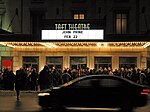Lytle Tunnel

The Lytle Tunnel is a vehicular tunnel that carries Interstate 71 (I-71) under the historic Lytle Park in Cincinnati, in the U.S. state of Ohio, connecting Fort Washington Way to the Northeast Expressway. It is a six-lane tunnel with three tubes. There is a two-lane southbound tube, a three lane-northbound tube, and a one-lane southbound tube that separates from the highway and serves as an exit ramp to the downtown area. The tunnel is ventilated by two grates in the northbound tube and the southbound exiting tube. It was completed in 1970. At 335 meters (1,099 feet), it is the longest vehicular tunnel in Ohio. It is also the only tunnel on I-71. During the construction of the Lytle Tunnel, many historic buildings were razed for the project. The old Lytle Park was similar to a town square, with many Greek Revival buildings surrounding the park. On the park's east side is the Taft Museum of Art. A few of the original buildings remain, including the Literary Club of Cincinnati, the Anna Louise Inn, Guilford School building, and the Phelps Apartments. A CB radio broadcast on channel 19, the most commonly used commercial trucking frequency, loops a warning about this turn and its hazards 24 hours a day, seven days a week.
Excerpt from the Wikipedia article Lytle Tunnel (License: CC BY-SA 3.0, Authors, Images).Lytle Tunnel
East 4th Street, Cincinnati Central Business District
Geographical coordinates (GPS) Address Nearby Places Show on map
Geographical coordinates (GPS)
| Latitude | Longitude |
|---|---|
| N 39.101666666667 ° | E -84.504166666667 ° |
Address
550 East Fourth Apartments
East 4th Street 550
45202 Cincinnati, Central Business District
Ohio, United States
Open on Google Maps







